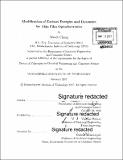| dc.contributor.advisor | Vladimir Bulović. | en_US |
| dc.contributor.author | Chang, Wendi | en_US |
| dc.contributor.other | Massachusetts Institute of Technology. Department of Electrical Engineering and Computer Science. | en_US |
| dc.date.accessioned | 2017-05-11T20:00:32Z | |
| dc.date.available | 2017-05-11T20:00:32Z | |
| dc.date.copyright | 2017 | en_US |
| dc.date.issued | 2017 | en_US |
| dc.identifier.uri | http://hdl.handle.net/1721.1/109011 | |
| dc.description | Thesis: Ph. D., Massachusetts Institute of Technology, Department of Electrical Engineering and Computer Science, 2017. | en_US |
| dc.description | Cataloged from PDF version of thesis. | en_US |
| dc.description | Includes bibliographical references (pages 157-171). | en_US |
| dc.description.abstract | Organic and nano-crystal thin film semiconductors have proven to be effective materials for a range of optoelectronic applications including light emitting diodes, visible wavelength lasers, photovoltaics, and sensors. Mediating photons and charges, excitons are responsible for electrical and optical properties in these energetically disordered media. To improve current technology and develop novel applications, a thorough understanding of exciton dynamics is crucial. This thesis focuses on modifying exciton dynamics in organic and nanocrystal thin films with spectroscopic monitoring for optoelectronic applications. First, we study local dielectric effects in doped organic thin films, which depends on material deposition and molecular density. An external pressure technique is used to modify molecular density, tuning exciton energies and dynamics as explained by solvation theory and exciton energy transfer. We extend this molecular density tuning method, coupled with other measurements, including optical imaging, magnetic field effect, and electric field effect to modify and monitor charge transfer (CT) exciton energy and dynamics. As intermediaries between excitons and free charges in organic photovoltaic donor-acceptor material systems, CT exciton state dynamics is still a subject of much debate. The effect of CT spin states on photocurrent generation is explored, revealing guidelines for material selection and molecule engineering with potential benefits in optimizing molecular density. Further investigation of low-energy CT exciton transport leads to evidence of spatial motion between interfacial states, driven by local energy disorder. These techniques and results directly apply to optimizing OPV devices, but may also be extended to other applications. This thesis also includes an investigate of ultrafast electric field effect on organic and colloidal quantum dot thin films, largely unexplored in previous works. We observe exciton luminescence and non-perturbative energy tuning of exciton states under terahertz electromagnetic radiation, developing a potential platform for detectors and cameras for coherent terahertz sensing. Lastly, we discuss a new fabrication technique to integrate organic thin films into micro-electro-mechanical system microcavity device designs. The demonstrated electrically tunable microcavity structures not only applicable as wavelength-tunable lasers and pressure sensors, but also presents a good example of fabrication flexibility and challenges of employing organic and nano-crystal thin films. | en_US |
| dc.description.statementofresponsibility | by Wendi Chang. | en_US |
| dc.format.extent | 171 pages | en_US |
| dc.language.iso | eng | en_US |
| dc.publisher | Massachusetts Institute of Technology | en_US |
| dc.rights | MIT theses are protected by copyright. They may be viewed, downloaded, or printed from this source but further reproduction or distribution in any format is prohibited without written permission. | en_US |
| dc.rights.uri | http://dspace.mit.edu/handle/1721.1/7582 | en_US |
| dc.subject | Electrical Engineering and Computer Science. | en_US |
| dc.title | Modification of exciton energies and dynamics for thin film optoelectronics | en_US |
| dc.type | Thesis | en_US |
| dc.description.degree | Ph. D. | en_US |
| dc.contributor.department | Massachusetts Institute of Technology. Department of Electrical Engineering and Computer Science | |
| dc.identifier.oclc | 986529435 | en_US |

